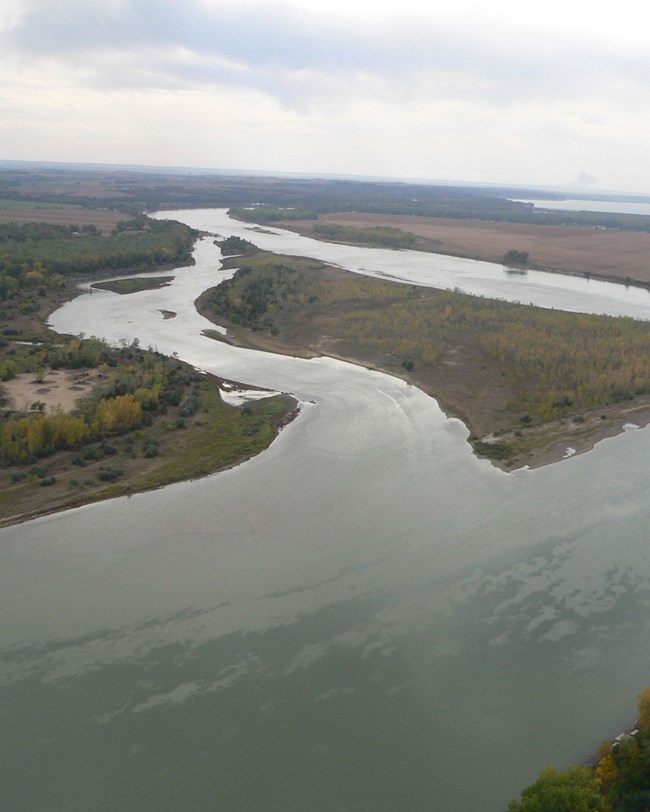Last updated: July 10, 2024
Article
NPS Geodiversity Atlas—Missouri National Recreational River, South Dakota and Nebraska
Geodiversity refers to the full variety of natural geologic (rocks, minerals, sediments, fossils, landforms, and physical processes) and soil resources and processes that occur in the park. A product of the Geologic Resources Inventory, the NPS Geodiversity Atlas delivers information in support of education, Geoconservation, and integrated management of living (biotic) and non-living (abiotic) components of the ecosystem.

Introduction
Missouri National Recreational River (MNRR) protects two stretches of the Missouri River separated by Lewis and Clark Lake in portions of Bon Homme, Charles Mix, Clay, Union, and Yankton Counties, South Dakota, and Boyd, Cedar, Dixon, and Knox Counties, Nebraska. Authorized on November 10, 1978, MNRR encompasses about 19,609 hectares (48,457 acres) and preserves the last unchannelized and unimpounded segments of the Missouri River along with its native floodplain forest, floodplain wetland, tallgrass, and mixed-grass prairie habitats (National Park Service 2016a). The 39-Mile District represents the western, upstream portion of MNRR and extends from Fort Randall Dam downstream to Running Water, South Dakota. Also included in the district are the last 13 km (8 mi) of Verdigre Creek and the lower 32 km (20 mi) of the Niobrara River at their confluence with the Missouri River. The 59-Mile District begins just below Gavins Point Dam and ends at Ponca State Park in Nebraska. The rich cultural history of MNRR dates back thousands of years and is recorded by prehistoric sites, old steamboat wrecks, Fort Randall, and numerous archeological and historical resources (National Park Service 2017c).
Geologic Setting
Missouri National Recreational River occupies the transition zone between the Great Plains and Central Lowland physiographic provinces in a region situated between the glaciated and unglaciated portions of the Missouri Plateau. The 39-Mile District of MNRR features a landscape characterized by steep, dissected chalkstone river bluffs, gently rolling hills, and flat agricultural land. Further downstream, the 59-Mile District occupies a wide, meandering river valley and features a mosaic of sandbars, snags, backwaters, islands, and tributary channels. Strata that underlie MNRR can be subdivided into two main groups based on age and lithology: (1) older Cretaceous rocks of the (in ascending order) Dakota Formation, Graneros Shale, Greenhorn Limestone, Carlile Shale, Niobrara Formation, and Pierre Shale; and (2) younger Quaternary units that include the Peoria Loess, glacial till, flood channel deposits, alluvial terraces, alluvium, and colluvium.
Regional Geology
Missouri National Recreational River is within both the Central Lowland Physiographic Province and the Great Plains Physiographic Province, and shares its geologic history and some characteristic geologic formations with a region that extends well beyond park boundaries.
- Scoping summaries are records of scoping meetings where NPS staff and local geologists determined the park’s geologic mapping plan and what content should be included in the report.
- Digital geologic maps include files for viewing in GIS software, a guide to using the data, and a document with ancillary map information. Newer products also include data viewable in Google Earth and online map services.
- Reports use the maps to discuss the park’s setting and significance, notable geologic features and processes, geologic resource management issues, and geologic history.
- Posters are a static view of the GIS data in PDF format. Newer posters include aerial imagery or shaded relief and other park information. They are also included with the reports.
- Projects list basic information about the program and all products available for a park.
Source: Data Store Saved Search 3016. To search for additional information, visit the Data Store.
A NPS Soil Resources Inventory project has been completed for Missouri National Recreational River and can be found on the NPS Data Store.
Source: Data Store Saved Search 3063. To search for additional information, visit the Data Store.

Related Links
Related Articles
Missouri National Recreational River
National Park Service Geodiversity Atlas
The servicewide Geodiversity Atlas provides information on geoheritage and geodiversity resources and values within the National Park System. This information supports science-based geoconservation and interpretation in the NPS, as well as STEM education in schools, museums, and field camps. The NPS Geologic Resources Division and many parks work with National and International geoconservation communities to ensure that NPS abiotic resources are managed using the highest standards and best practices available.
